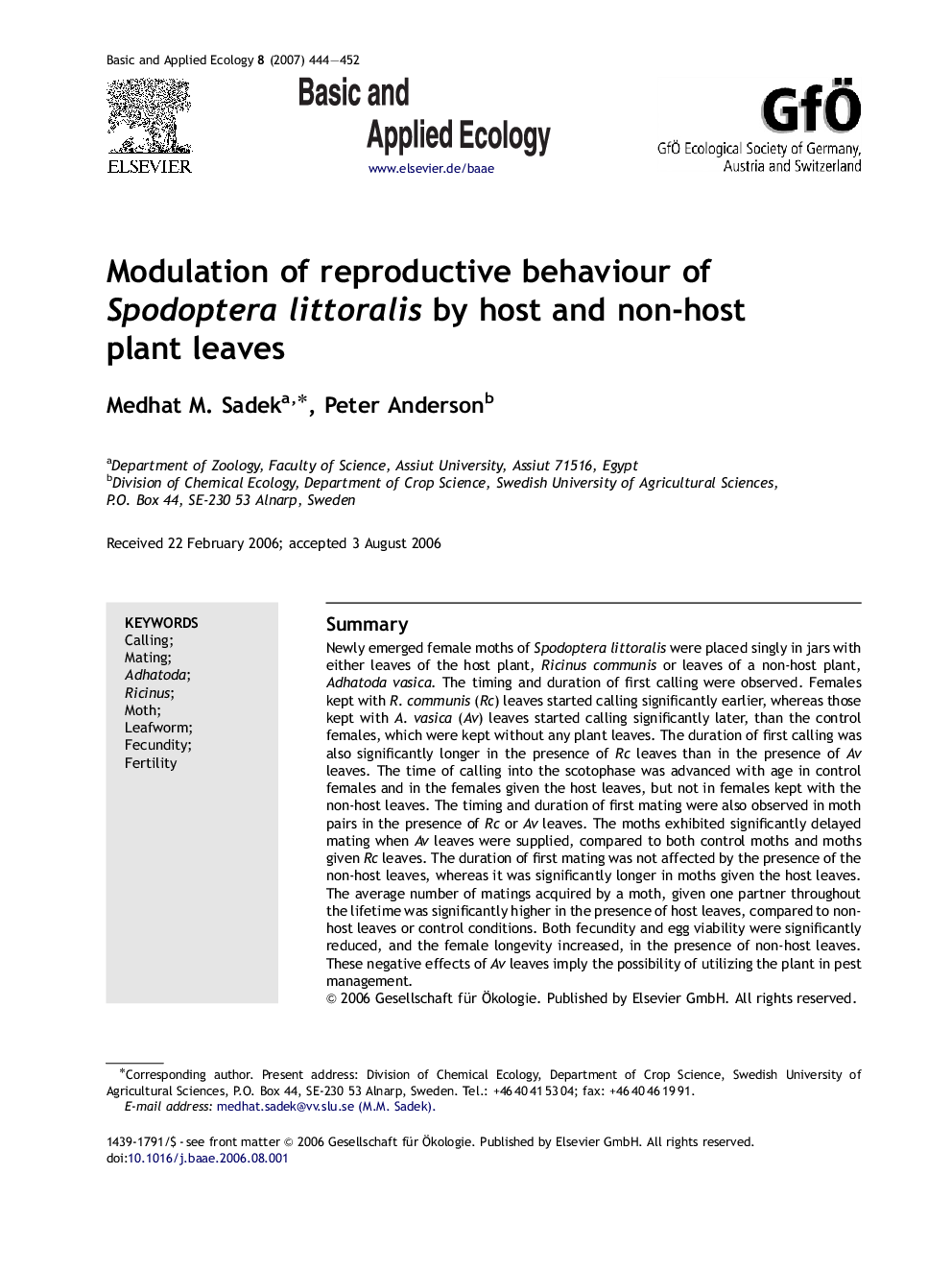| Article ID | Journal | Published Year | Pages | File Type |
|---|---|---|---|---|
| 4384969 | Basic and Applied Ecology | 2007 | 9 Pages |
SummaryNewly emerged female moths of Spodoptera littoralis were placed singly in jars with either leaves of the host plant, Ricinus communis or leaves of a non-host plant, Adhatoda vasica. The timing and duration of first calling were observed. Females kept with R. communis (Rc) leaves started calling significantly earlier, whereas those kept with A. vasica (Av) leaves started calling significantly later, than the control females, which were kept without any plant leaves. The duration of first calling was also significantly longer in the presence of Rc leaves than in the presence of Av leaves. The time of calling into the scotophase was advanced with age in control females and in the females given the host leaves, but not in females kept with the non-host leaves. The timing and duration of first mating were also observed in moth pairs in the presence of Rc or Av leaves. The moths exhibited significantly delayed mating when Av leaves were supplied, compared to both control moths and moths given Rc leaves. The duration of first mating was not affected by the presence of the non-host leaves, whereas it was significantly longer in moths given the host leaves. The average number of matings acquired by a moth, given one partner throughout the lifetime was significantly higher in the presence of host leaves, compared to non-host leaves or control conditions. Both fecundity and egg viability were significantly reduced, and the female longevity increased, in the presence of non-host leaves. These negative effects of Av leaves imply the possibility of utilizing the plant in pest management.
ZusammenfassungFrisch geschlüpfte Spodoptera littoralis Weibchen wurden einzeln in Behälter mit Blättern der Wirtspflanze Ricinus communis oder Blättern der Nicht-Wirtspflanze Adhatoda vasica plaziert. Der Zeitpunkt und die Dauer des ersten Lockrufs wurden gemessen. Im Vergleich zu Kontrollweibchen ohne jegliche Blätter begannen Weibchen in Behältern mit R. communis signifikant früher mit dem Rufen, Weibchen in Behältern mit A. vasica signifikant später. Auch die Ruflänge in Gegenwart von R. communis Blättern war signifikant länger als in Gegenwart von A. vasica Blättern. In einer Folge von Skotophasen begannen Weibchen auf Wirtsblättern und Kontrollweibchen zunehmend früher mit dem Rufen, nicht jedoch die Weibchen auf Nichtwirtsblättern. Auch der Zeitpunkt und die Dauer der ersten Verpaarung wurden in Anwesenheit von R. communis oder A. vasica Blättern bestimmt. In Gegenwart von A. vasica Blättern erfolgten Verpaarungen signifikant später als in Gegenwart von R. communis Blättern oder bei den Kontrollpaaren. Die Dauer der ersten Verpaarung wurde durch die Anwesenheit von Nichtwirtsblättern nicht beeinflußt, jedoch war sie signifikant länger mit Wirtsblättern. Die durchschnittliche Anzahl Verpaarungen einer Motte in ihrer Gesamtlebensdauer, unter Bereitstellung eines Partners, war in Gegenwart von Wirtsblättern signifikant höher als bei den anderen beiden Gruppen. In Gegenwart von Nicht-Wirtsblättern war die Lebensdauer signifikant erhöht, Fekundität und Ei-Vitalität signifikant reduziert. Die negativen Effekte von A. vasica Blättern können möglicherweise im Pflanzenschutz genutzt werden.
